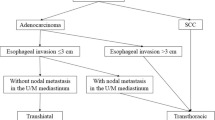Abstract
Background
Among patients who undergo gastric tube reconstruction after esophagectomy, it is generally accepted that the incidence of reflux esophagitis (RE) is significantly lower in patients with neck anastomosis than in those with intrathoracic anastomosis. However, the true impact of the level of anastomosis on RE currently remains unclear.
Methods
We examined 53 patients with thoracic esophageal cancer underwent radical esophagectomy with gastric tube reconstruction and neck anastomosis. The level of anastomosis was assessed by measuring the distance from the sternal notch to the stapled ring by computed tomography. The relative level of anastomosis was calculated by the distance from the sternal notch to the most caudal side of the stapled ring (mm)/height (cm).
Results
The relative level of anastomosis in 30 (56.6%) patients showed <0, which indicated that anastomosis in these patients was located at a lower level than the sternal notch. The mean relative level of anastomosis was significantly lower in patients with RE (grade A to D) than in those without RE (grade N) (−0.062 vs. −0.012 mm/cm, respectively; p = 0.043). RE was more severe with a lower relative level of anastomosis (p for trends = 0.044).
Conclusions
The level of anastomosis in patients with gastric tube reconstruction following esophagectomy was associated with the incidence of RE. The displacement of anastomosis into the thoracic cavity was detected in approximately half of the patients with neck anastomosis. RE was more severe with a lower level of anastomosis, even in patients with neck anastomosis.



Similar content being viewed by others
References
Shibuya S, Fukudo S, Shineha R et al (2003) High incidence of reflux esophagitis observed by routine endoscopic examination after gastric pull-up esophagectomy. World J Surg 27:580–583. doi:10.1007/s00268-003-6780-7
Yamamoto S, Makuuchi H, Shimada H et al (2007) Clinical analysis of reflux esophagitis following esophagectomy with gastric tube reconstruction. J Gastroenterol 42:342–345. doi:10.1007/s00535-007-2011-6
Yuasa N, Sasaki E, Ikeyama T et al (2005) Acid and duodenogastroesophageal reflux after esophagectomy with gastric tube reconstruction. Am J Gastroenterol 100:1021–1027. doi:10.1111/j.1572-0241.2005.41109.x
Bonavina L, Anselmino M, Ruol A et al (1992) Functional evaluation of the intrathoracic stomach as an oesophageal substitute. Br J Surg 79:529–532
Armstrong D, Bennett J, Blum A et al (1996) The endoscopic assessment of esophagitis: a progress report on observer agreement. Gastroenterology 111:85–92. doi:10.1053/gast.1996.v111.pm8698230
Yajima K, Kosugi S, Kanda T et al (2009) Risk factors of reflux esophagitis in the cervical remnant following esophagectomy with gastric tube reconstruction. World J Surg 33:284–289. doi:10.1007/s00268-008-9856-6
D’Journo XB, Martin J, Rakovich G et al (2009) Mucosal damage in the esophageal remnant after esophagectomy and gastric transposition. Ann Surg 249:262–268. doi:10.1097/SLA.0b013e31818eec06
Bemelman WA, Verburg J, Brummelkamp WH, Klopper PJ (1988) A physical model of the intrathoracic stomach. Am J Physiol 254:G168–G175
Nakabayashi T, Mochiki E, Kamiyama Y et al (2013) Impact of gastropyloric motor activity on the genesis of reflux esophagitis after an esophagectomy with gastric tube reconstruction. Ann Thorac Surg 96:1833–1838. doi:10.1016/j.athoracsur.2013.06.034
Collard J, Romagnoli R, Salizzoni M (2001) Denervated stomach as an esophageal substitute recovers intraluminal acidity with time. Ann Surg 233:509–514. doi:10.1097/00000658-200104000-00005
Viklund P, Wengström Y, Rouvelas I et al (2006) Quality of life and persisting symptoms after oesophageal cancer surgery. Eur J Cancer 42:1407–1414. doi:10.1016/j.ejca.2006.02.005
Malmström M, Klefsgard R, Ivarsson B et al (2015) Quality of life measurements as an indicator for timing of support after oesophagectomy for cancer: a prospective study. BMC Health Serv Res 15:96. doi:10.1186/s12913-015-0747-x
Mori N, Fujita H, Sueyoshi S et al (2007) Helicobacter pylori infection influences the acidity in the gastric tube as an esophageal substitute after esophagectomy. Dis Esophagus 20:333–340. doi:10.1111/j.1442-2050.2007.00718.x
Nishimura K, Tanaka T, Tsubuku T et al (2012) Reflux esophagitis after esophagectomy: impact of duodenogastroesophageal reflux. Dis Esophagus 25:381–385. doi:10.1111/j.1442-2050.2011.01268.x
Author’s contribution
Study conception and design: MS, acquisition of data: TY, YK, HH, KH, analysis and interpretation of data: MS, MS, TM, TY, drafting of manuscript: MS, critical revision: HK.
Author information
Authors and Affiliations
Corresponding author
Ethics declarations
Conflict of interest
The authors declare no conflict of interest associated with this manuscript.
Rights and permissions
About this article
Cite this article
Sakai, M., Sohda, M., Miyazaki, T. et al. Impact of the Level of Anastomosis on Reflux Esophagitis Following Esophagectomy with Gastric Tube Reconstruction. World J Surg 41, 804–809 (2017). https://doi.org/10.1007/s00268-016-3786-5
Published:
Issue Date:
DOI: https://doi.org/10.1007/s00268-016-3786-5




